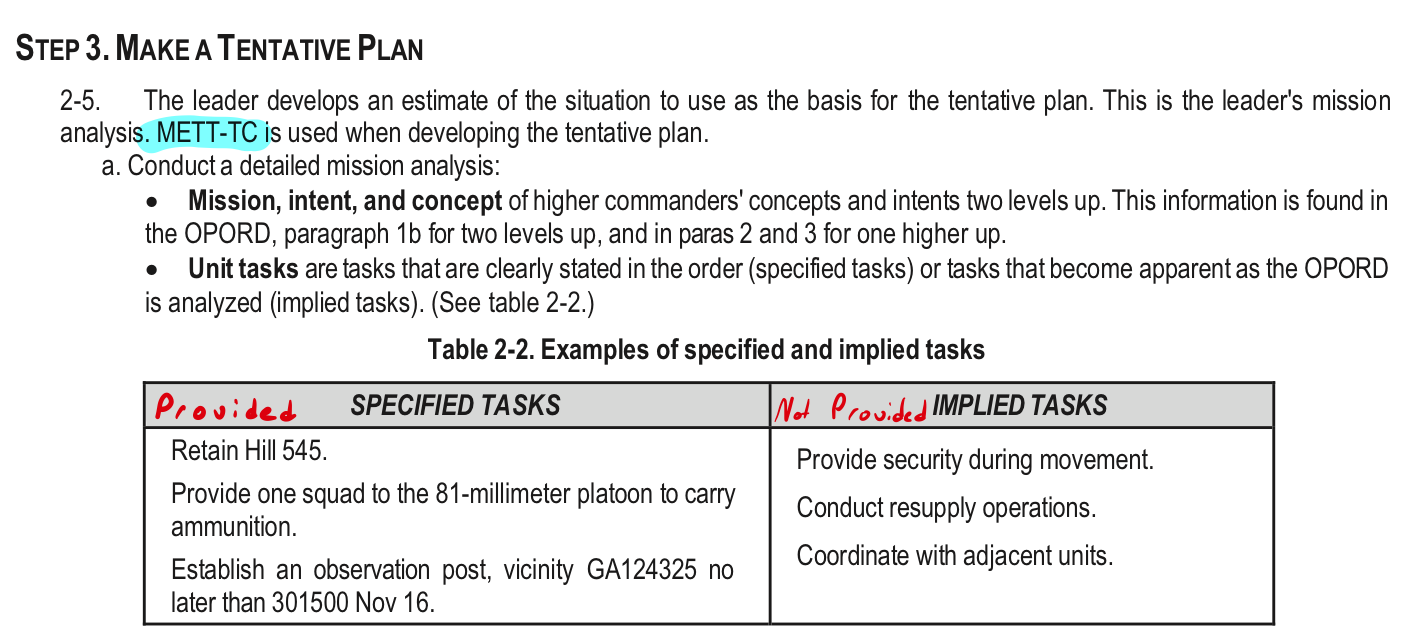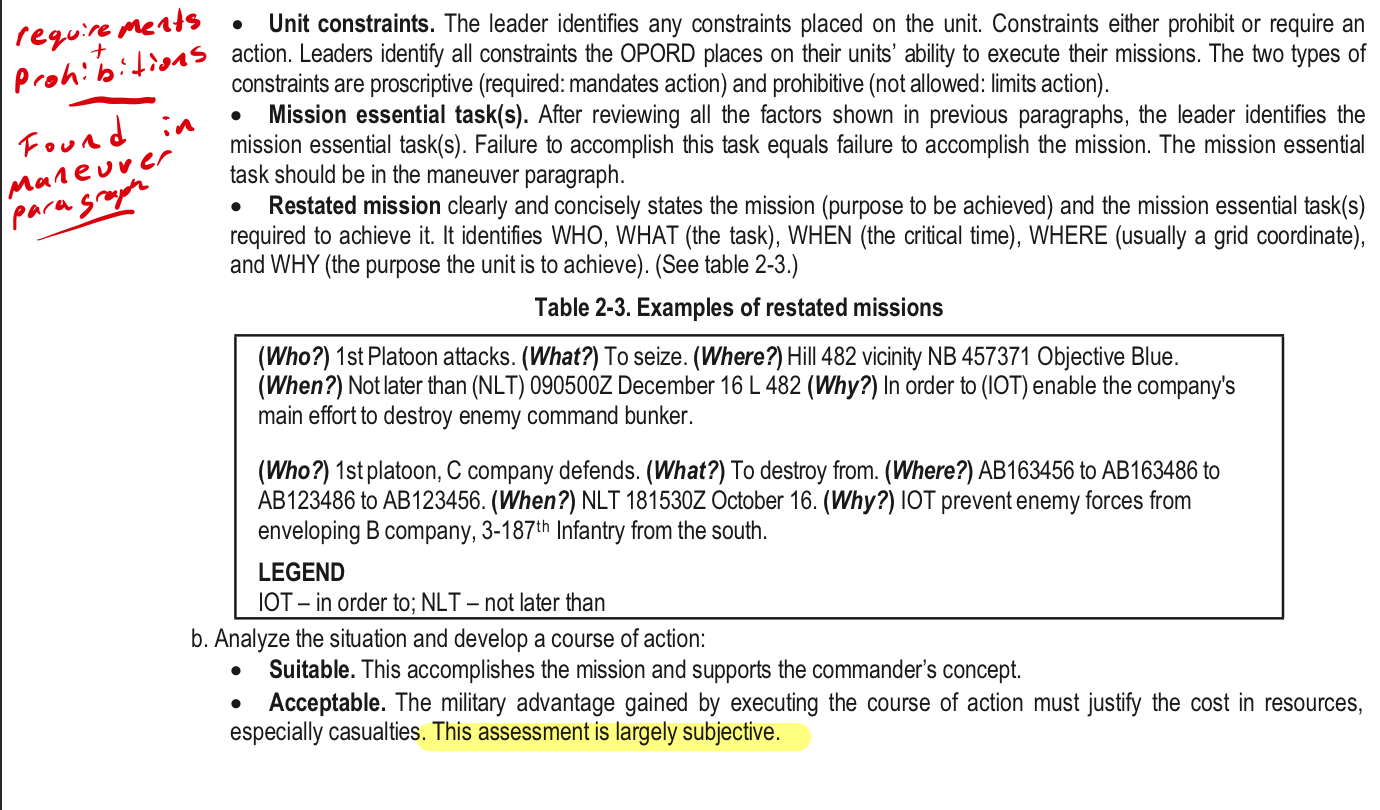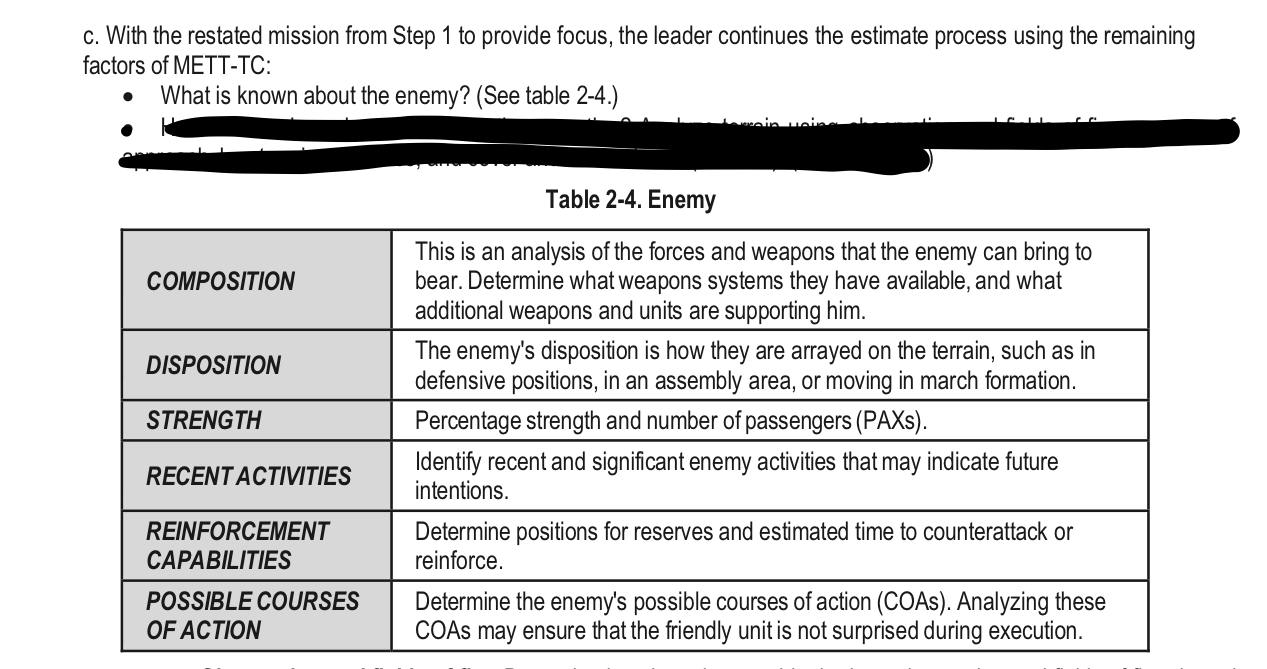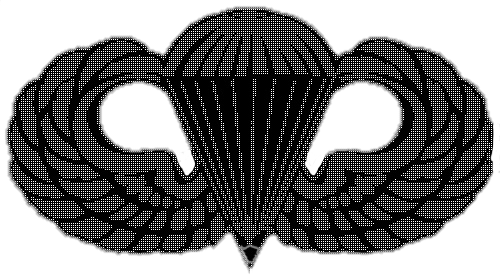I have made many mistakes online, but the one that will likely haunt me longest is committing to this exegesis on our favorite Training Circular. This was a helluva task for anyone but my professional and personal obligations have really made writing difficult, thus my tardiness. But enough whining. On with the show.
We left off after we discussed Chapter 1 and Leadership of the Ranger Handbook, which is one of the greatest chapters in all formal military writing in my opinion. The break I took was partly personal, but absolutely had a heavy dose of knowing what is ahead. Chapter 2 begins Operations, and this is probably the densest vein of ore we have to mine together. To a layman this is going to appear very esoteric but also unnecessarily descriptive. There is a reason for this, and the most direct way to say it is to state that there is a lot in creating a well defined and planned operation, and it is all very necessary and appropriate to describe so than literally anyone can do it. This is how to make a plan, for dummies.

The opening explanation is simple. Obviously a team and its leadership is going to use whatever time is available plan an action, but certain core principles and tools will always make this more effective, and that is the core of what we will begin discussing now. The most important of these principles and tools are what is known as the Troop Leading Procedures.
This chapter really begins there at 2-2 when it says the leader is alerted for a mission and implies in 2-3 that OPORDs and FRAGORDs (don't forget to keep your acronym listing handy) are the most likely notification mechanism. This is true but it is important to note that a change on the battlefield can be a catalyst for alteration or implementation of a plan.
The 1/3rd and 2/3rd planning principle might confuse you if this has only been reading material and not something you have put into practice. Something not seen in the text here but already introduced in our chapter on the PL is backward or reverse planning. In order to know how long you have to plan or rehearse you must deduct this time from that available. Now you will find out later most missions will come with a NLT time, which just means "No Later Than." Consider it a deadline. With that known a leader should start and work backwards through the key tasks required to the present moment. Whatever is not used for actually briefing or conducting the operation should be then used for planning and preparation. Now that small sliver of time (it is rarely enough) should be further cut into thirds, and as the leader you only get one third. The other two go to your subordinate leaders and their Soldiers. That is what is meant by the 1/3rd and 2/3rd rule.
There is a lot of ink spilled into that description of a WARNORD. It's all good and relevant but would encourage folks to not get too bent on formats or making sure all of the suggested material is included. Tell your Soldiers what you know, what you are thinking you will do, and then get back to completing the plan and letting them get prepared. The OPORD is already a tremendous drag on your timeline and spending undue minutes formatting or trying to fill out a WARNORD is a worthless waste. It can be said that the greatest utility of a WARNORD is it's brevity and speed of transmission.
That all said, we can dip into the bullets for a little bit of exposition:
- Type of operation - should be self explanatory but think raid, ambush, reconnaissance, etc
- General location of the operation- attempt to pin down the grid to the closest degree possible, eight to ten digits is best
- Initial operational timeline- from right now to NLT
- Reconnaisance to initiate- could be what needs to be determined right now or just before the operation is executed (be sure to be specific when this is cited)
- Movement to initiate- just as important to state as in the previous bullet, make sure your Soldiers know when this movement is planned
- Planning and preparation instructions- any specific guidance you can provide and of course the timeline for this
- Information requirements- things that would be nice to know and might benefit planning
- Commander's critical information requirements (CCIR)- things that must be known in order to make or complete the timely plan
So again, those first two steps we went through in nearly eight hundred words? Those were completed immediately and in series. The rest of these steps are going to be a jumbled fucking mess so to speak, and are repeatedly going to step all over each other when conducted properly. Your job as a leader of Soldiers would be to ensure they are not neglected or mismanaged, as even though we expect them to become a soup, your unit will be the ones to eat that soup later.

I am half inclined to make this next step its own post it is so rich with detail and wanting for explanation. But I won't, so here we go. Making a tentative plan first brings up that popular acronym, METT-TC. If you recall we discussed this when we covered the PSG. I don't want to rehash the entire thing over again, but all the factors are important, but are more or less arranged in order of importance. This is a great tool for forming that tentative plan.
But while an initial plan can be loose it is not sufficient. A detailed plan has a much greater chance of being successful. In order to do that we should perform a better analysis. Mission, intent, and concept have already been covered in some detail earlier when we discussed the PL. The idea of course is to focus first on the literal stating of the mission, what your leaders want you to achieve with this mission, and what doctrinal concept is going to govern the effort, respectively.
Unit tasks are twofold, the first type of task is very easy to understand. These are the tasks specified in the order. The trick there is just to identify them and make them each a part of the mission. The next bit is harder and not something well done by everyone. In fact it is so often screwed up it has become a bit of a common item pointed out in professional development. The second type of task are the implied ones, and a good leader can quickly and effectively suss them out from the specified. I think the table does a good job providing some examples here as well.

Another set of items to be sussed out from your mission and not always clear are the constraints. This can seem confusing but really think of it like things you must do to be successful and require actions, and things that you cannot do and are prohibited. Taking these out and examining them might seem pointless but are important. Examples most often used are the crossing of friendly lines, known bombardments, or NBC protection requirements.
I can't imagine what a reader who isn't steeped in this stuff is going through right now, as revisiting this after so many years I can remember how important these parts are, but also acknowledge how they don't seem so and are seemingly obvious. I think the important take I would encourage you to maintain here is that by making this a process you ensure that anyone can do it, and that it is thorough. A mission essential task or tasks seems redundant at this point, but again just realize your intent is to keep making sure you find all the items necessary to succeed and accomplish the point of the mission. There tends to be a common patois for these items, but they are not doctrinal. Example here would be "seize," "neutralize," and/or "destroy."
Most of what we have covered so far is fairly esoteric for the folks on the line, at least in my experience. The format for the mission statement is not though. In fact this seems to be the most popular part of the whole OPORD process. For some reason it is the most memorable. You will see later in the delivery it is always read twice, but there is just something about this format that seems cinematic. When you get or give your first OPORDs this is the thing you remember feeling. It just makes it all seem very real. Read the example for the effect. The parts are exceedingly memorable. To this day I sometimes at work I use NLT and IOT language when describing a task.
Courses of action are an entire subject of their own as well and most commonly come up when discussing the enemy, but for our purposes here we are talking friendly actions. Suitable is the course of action (or actions) that most closely meet the concept from higher. Acceptable are those that do it but less perfectly and as one might see already, is somewhat a subjective enterprise.

The latest version of the Handbook places this table in poor place so I blacked out a distraction between it and the subject. I don't want to spend too much time here because this table is more a little easier to grok than other parts. While this is easy to understand the process what is determined is the goal. In a theater where the enemy has numbers, capabilities for reinforcement, and are able to exercise freedom of movement- a plan for attack must obviously be more cautious.

OAKOC isn't just a fun acronym that sounds like surprise after a first date. This is one of the most useful ways to view terrain both on the ground as well as from a map reconnaissance. The order has changed over time, as the first time I encountered this it was OCOKA. To me this implies some order of importance which it seems to track. Observation and fields of fire are obviously the most important as whomever can enjoy enfilade can kill the enemy best.
It's interesting to see avenues of approach if you knew the older acronym, as you might think that cover and concealment are more vital but the truth is almost any place that enjoys the other factors will have cover and concealment. But avenues of approach are more important because of the ability to move units and quickly, which improves a situation for a force by allowing you to have available not just those troops already on the field. Meaning via this avenue of approach, at any moment you can to bring up QRF (quick reaction forces) or reinforcements. The ability to bring numbers quickly should be put right behind the ability to apply direct fire, and is just so in the acronym.
Key terrain is another item that moved in the acronym update, coming along with avenues of approach. If you have been to a civil war battlefield key terrain is an easier concept to grasp. Some ground just seems "good" compared to others and it is likely going to be optimal in all the subjects of this acronym, but it is in areas where these are most closely concentrated. Steep hills, dense forests, interconnected stream beds, are all examples what can be considered key terrain.
Obstacles can be natural or man made, and of the man made they can be friendly or enemy. Probably the easiest obstacles to consider for these categories are a deep or rushing river, or a minefield. Each of these offer restrictions to unit movement.
We covered the idea that cover and concealment moved down far in this order of concern, and I think it is because it is so intrinsic to most of the other concerns, and almost any place on earth is going to offer up some varying capabilities of each.

We started going through these TLPs by saying that the first three were followed in order and up front but that steps 4 onward were "a jumbled fucking mess" for the leader to keep track and complete. Not only is the execution jumbled, there is a lot said in very few words. Initiating movement for all or part of the unit can come pretty much at any time, and can happen more than once. Reconnaissance is a very important step that helps provide intelligence about the objective, the enemy, and the terrain. Most often a map reconnaissance is all that is available, but occasionally it is possible to get another unit (like battalion scouts), or break off part of your unit and have them perform an onsite reconnaissance. Completing the plan is simple enough, you are just filling the gaps and developing your OPORD.

Very soon we will have an entire post dedicated to the OPORD so we shouldn't spoil it with much, just know that when we do this it is best to have some visuals to support it. If you can actually show your team the literal objective that is best, but obviously that isn't suitable to offensive operations. Most likely a terrain model or a sketch will be the best you can afford when on the offense.

Being north of two thousand words already we can finally wrap on this process with this final step, which is the last catch all bucket: supervise and refine. This comes down to ensuring that the troops begin to practice and rehearse the events. Rehearsals have been touched on before but cannot be overstated in importance. You do not want the first time a thing is done to be when it must be completed on an objective. Back briefing is a form of rehearsal and is a great way to evaluate understanding of the mission critical tasks and roles. The PLs should undertake these with the SLs, the SLs should do this with the TLs, and the TLs should insist each Soldier does this with them. The why and how is pretty well demonstrated here in the text and a reader should take them to heart.

A bit of explanation of the types of rehearsals is listed here, as well of techniques. I think a well enough job is done without me blathering on about it, and very little is to be added. The point is just to always expand the participation to as many members of the mission as possible, and make it as lifelike as can be done without harming the timeline or operational security.

Anyone not working on the plan should be working to finish the preparation, rehearsal, and briefing of the plan. If you are a leader, any leader, participating in the mission you should be looking at your peers' and subordinates's equipment and talking about the work to be done. Check them, check yourself, check the plan. This jumbled process depends on multitasking and everyone putting in the effort. A favorite practice of mine was to do a lot of this checking of understanding while packing, traveling, or waiting. If you are assembled amongst any of the patrol prior to movement or while idle, talk through the plan and ask questions.
This concludes the section on the Troop Leading Procedures. I appreciate everyone's patience in the long delay on getting back to the task of working through this dense manual, and especially in enduring so many words. Look forward to our next section and covering a format we discussed in Step 2, the WARNORD.
